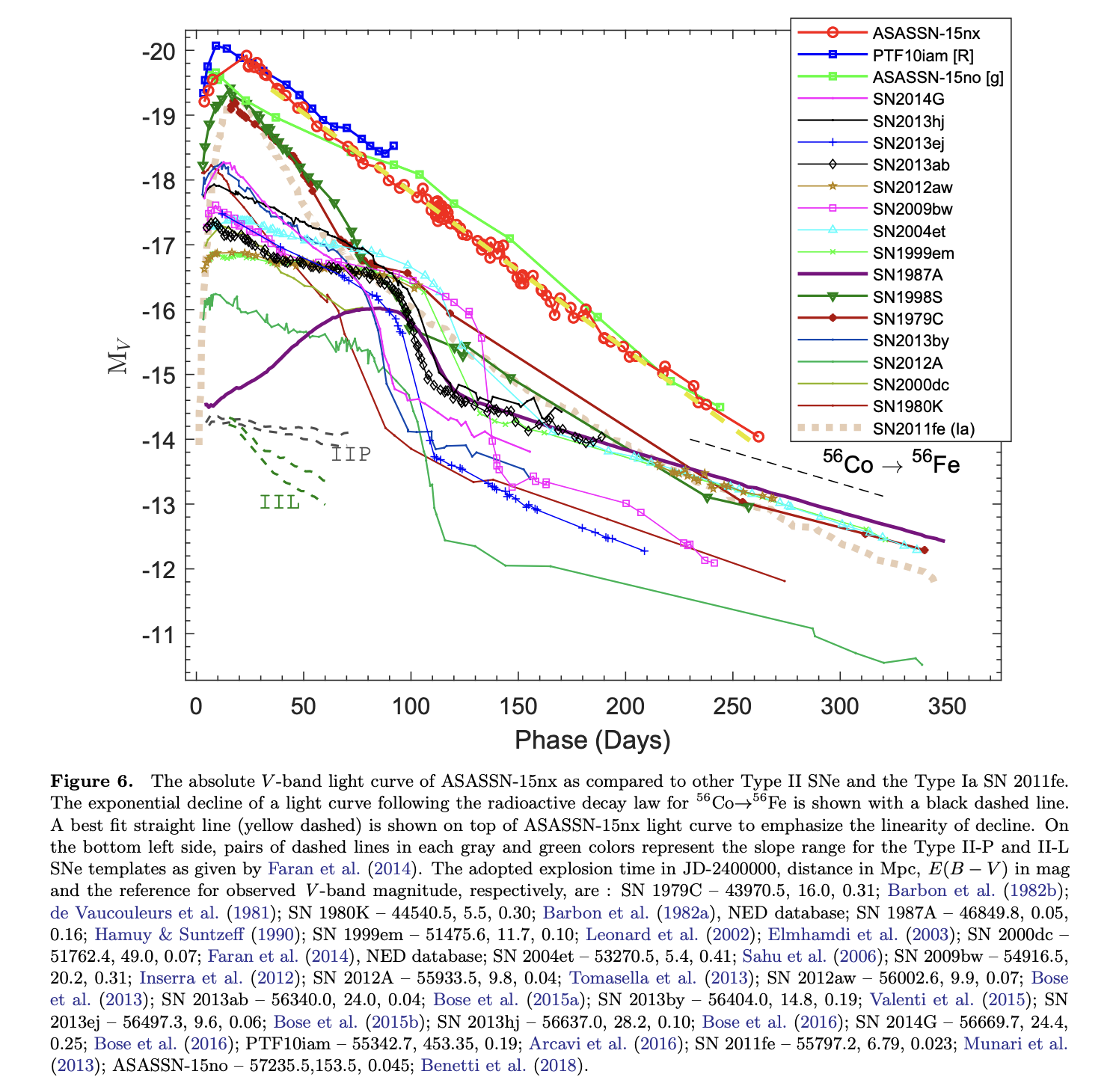Padova-Asiago Supernova Group
Highlights
ASASSN-15nx: A Luminous Type II Supernova with a Perfect Linear Decline
Bose, S. et al. 2018, ApJ 862, 107 (link to pdf)
We report a luminous Type II supernova, ASASSN-15nx, with a peak luminosity of M_V=-20 mag, that is between typical core-collapse supernovae and super-luminous supernovae. The post-peak optical light curves show a long, linear decline with a steep slope of 2.5 mag/100 days (i.e., an exponential decline in flux), through the end of observations at phase ~260 days. In contrast, the light curves of hydrogen rich supernovae (SNe II-P/L) always show breaks in their light curves at phase ~100 days, before settling onto Co56 radioactive decay tails with a decline rate of about 1 mag/100 days. The spectra of ASASSN-15nx do not exhibit the narrow emission-line features characteristic of Type IIn SNe, which can have a wide variety of light-curve shapes usually attributed to strong interactions with a dense circumstellar medium (CSM). ASASSN-15nx has a number of spectroscopic peculiarities, including a relatively weak and triangularly-shaped H-alpha emission profile with no absorption component. The physical origin of these peculiarities is unclear, but the long and linear post-peak light curve without a break suggests a single dominant powering mechanism. Decay of a large amount of Ni56 (M_Ni56 = 1.6 +/- 0.2 M_sun) can power the light curve of ASASSN-15nx, and the steep light-curve slope requires substantial gamma-ray escape from the ejecta, which is possible given a low-mass hydrogen envelope for the progenitor. Another possibility is strong CSM interactions powering the light curve, but the CSM needs to be sculpted to produce the unique light-curve shape and to avoid producing SN IIn-like narrow emission lines. 124
Bose, S. et al. 2018, ApJ 862, 107 (link to pdf)
We report a luminous Type II supernova, ASASSN-15nx, with a peak luminosity of M_V=-20 mag, that is between typical core-collapse supernovae and super-luminous supernovae. The post-peak optical light curves show a long, linear decline with a steep slope of 2.5 mag/100 days (i.e., an exponential decline in flux), through the end of observations at phase ~260 days. In contrast, the light curves of hydrogen rich supernovae (SNe II-P/L) always show breaks in their light curves at phase ~100 days, before settling onto Co56 radioactive decay tails with a decline rate of about 1 mag/100 days. The spectra of ASASSN-15nx do not exhibit the narrow emission-line features characteristic of Type IIn SNe, which can have a wide variety of light-curve shapes usually attributed to strong interactions with a dense circumstellar medium (CSM). ASASSN-15nx has a number of spectroscopic peculiarities, including a relatively weak and triangularly-shaped H-alpha emission profile with no absorption component. The physical origin of these peculiarities is unclear, but the long and linear post-peak light curve without a break suggests a single dominant powering mechanism. Decay of a large amount of Ni56 (M_Ni56 = 1.6 +/- 0.2 M_sun) can power the light curve of ASASSN-15nx, and the steep light-curve slope requires substantial gamma-ray escape from the ejecta, which is possible given a low-mass hydrogen envelope for the progenitor. Another possibility is strong CSM interactions powering the light curve, but the CSM needs to be sculpted to produce the unique light-curve shape and to avoid producing SN IIn-like narrow emission lines. 124
